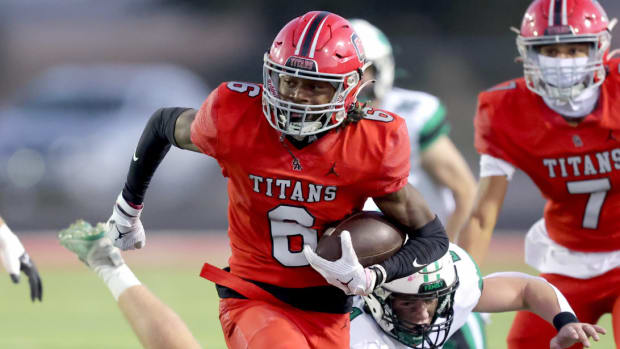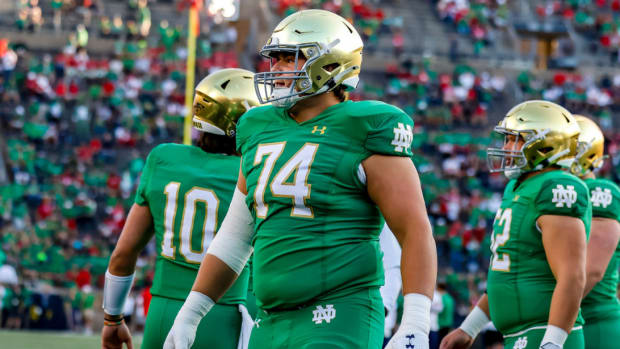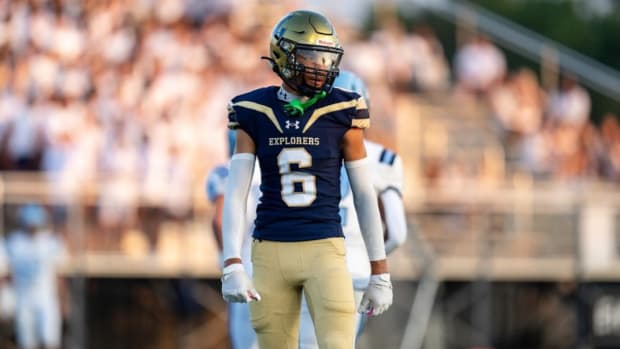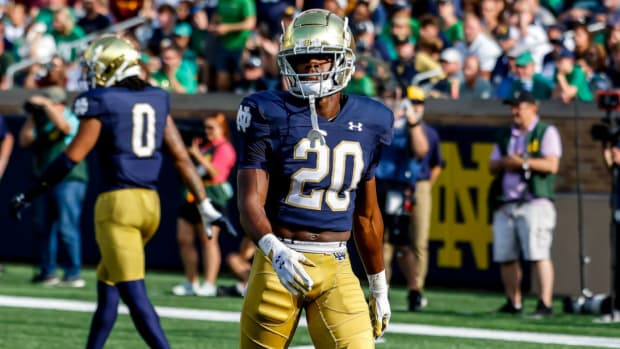Notre Dame Must Make Better Use Of Tight Ends And Backs In The Pass Game
There is no doubt that Notre Dame's pass game must improve dramatically, and do so in a hurry, if the Irish are going to have an offense capable of leading this team to a playoff victory and ultimately a national championship.
Adding things like RPOs are certainly a very key ingredient, but they are just one part of the changes that are needed. Two more key ingredients to a successful offense, and then a successful pass game, is making sure your best players are on the field and then building your system around them.
Notre Dame recruits tight end as well as any program in the country, and the Irish backfield is growing increasingly loaded. Returners Kyren Williams and Chris Tyree are talented players and are unique in that they bring pass game potential beyond your normal running back.
In 2020 the Irish coaches used the tight ends a lot, and I mean A LOT, at least in terms of snaps. Notre Dame's tight ends played a combined 1,487 snaps in 12 games last this past season (according to Pro Football Focus), compared to 1,226 snaps in 13 games the prior season when they had Cole Kmet also on the roster.
Compare that to Alabama (1,155 snaps) and Clemson (1,043). The Tide played one more game than the Irish while the Tigers played the same number of games.
This is not an issue or a criticism. When you believe your most talented players are tight ends by all means, use them! Notre Dame's tight ends certainly put up quality numbers, and the backs had their moments as well. The issue, however, is that Notre Dame has developed some tendencies when it comes to how it uses its tight ends and running backs, or perhaps a better way of expressing it is how they don't use those two positions.
Simply put, Notre Dame must do a better job using its tight ends in the pass game, and it needs to completely rethink and revamp how it uses its backs in the pass game. These changes might not have a significant impact on the number of catches made by those positions, but the yards will improve (as will the yards per catch), they will likely score more in the pass game and just as important, those changes will make life easier on the Irish receivers, and much harder on opposing defenses.
I'm sure there are some heads exploding right now, and those who think the coaching staff makes all the right decisions and is infallible are running to their keyboards or grabbing their phones now to complain about that statement. Take a deep breath before you do that, look at the graph below and then at least listen to the explanation.
This chart shows the number of snaps from the rotation tight ends and backs (regulars, non mop-up minutes) and how often they run a route when on the field. The percentage refers to the number of routes per snap. For the backs I do not believe it refers to just free-release routes, and also applies to check releases out of the backfield where the back actually gets out.
As you can clearly see, compared to the two best programs in the country, Alabama and Clemson, the Irish aren't anywhere close to them when it comes to using their backs and tight ends in the pass game.
While the tight ends are a bit more comparable, Notre Dame's running backs run the fewest routes of any of the teams displayed in this graph, and in the instance of all but two programs, significantly less. When you have Williams in your backfield this disparity should not be nearly as great, and it's something that needs to change.
Even looking at the tight ends there's a difference. Alabama, Clemson and Oklahoma all have their tight ends running more routes per snap than Notre Dame. Now let me get into three areas this matters and what must change.
1. SECOND AND THIRD TIGHT ENDS AREN'T BEING USED ENOUGH
Mayer was used to run a route on 59.9% of his snaps, which is a very high number and shows he was clearly a pass game weapon. I have no complaints with how often Mayer was used. I do, however, see an issue with how infrequently the second tight end was used, and the third tight end was downright problematic.
Alabama's top two tight ends had 54.8% and 45.9% route percentages and Clemson's top two tight ends had a 56.2% and 45.2% route percentage. Notre Dame's second tight end - Tommy Tremble - ran a route on just 39.0% of his snaps, compared to 45.9% for Alabama's second tight end and 45.2% for Clemson's second tight end. In 2019 Tremble was used to run routes on 48.7% of his pass snaps, so there was a very clear change this season.
Tremble's highest usage performance this season was in the Nov. 7 victory over Clemson. Perhaps that's just a coincidence, but if you go back and watch how impactful Tremble was early in that game and then go look at how many one-on-one's the Irish receivers got down the field after that and I don't think you can make that argument.
This means when Notre Dame was in 12 personnel (one back, two tight ends) its second tight end was used far less in the pass game. That means one less weapon out in a route, one less weapon for the quarterback and one less pass catcher to threaten the defense.
The bigger issue was how frequently Notre Dame was in three tight end packages. That third tight end - Brock Wright - played 345 snaps this season. He ran a route on just 92 of those snaps, which is just a 26.7% route percentage. Alabama's third tight end played just 91 snaps and Clemson's played just 126 snaps. Wright's snaps were up from 148 in 2019, but his route percentage was down almost 10%.
I am not complaining about Wright playing as much as he did, I'm complaining about how infrequently Tremble and Wright were used in the pass game. If you look at those numbers it gives defenses serious tells about what Notre Dame is going to be doing in its 12 and 13 personnel packages, which were a big part of the offense.
A good defensive coordinator would have known pretty early in the season that when Wright was on the field he wasn't running a pass route, and even beyond that it was a heavy, heavy running alignment. That's normally the case for most teams, but since Notre Dame used three tight ends so frequently it becomes an even bigger issue.
Beyond that, even when Notre Dame did throw out of its 12 and 13 personnel the lower tight end usage in the pass game meant that Notre Dame had fewer pass receivers out in routes, which makes it easier for defenses to limit the pass game. Combine that with how infrequently the backs were released in routes (compared to the other programs) and you can get the picture, fewer weapons in the pass game, fewer threats to the defense, easier job of covering everyone up.
Combine those two factors together and there were far, far too many snaps this season when Notre Dame had just two or three receivers out in routes. Unless you have DeVonta Smith or Chase Claypool or Tee Higgins on the outside this can be a major problem, and it played a huge factor in the pass game struggling as much as it did and it played a major role in why quarterback Ian Book had the lowest passer rating of his career ... by far.
When thinking of how poor Notre Dame was in the red zone, it should also be noted that Notre Dame's tight ends combined for just two touchdowns last season. Every team mentioned above had more, and every team but North Carolina had at least twice as many touchdowns from its tight ends.
2. STRETCH THE FIELD MORE
Mayer and Tremble were both targeted on just three balls that traveled at least 20 yards past the line of scrimmage, and they combined for just two catches. Wright was never targeted on a throw that traveled more than 10 yards past the line.
Beyond not using their tight ends enough in the pass game relative to snaps played, Notre Dame didn't use those tight ends to threaten defenses down the field. This is a bad combination and perhaps hindered the run game even more than it hindered the pass game.
Safeties can be a lot more aggressive coming downhill and attacking the run game when an offense is so frequently in two and three tight end packages but rarely uses them to stretch the field.
By comparison, Cole Kmet was targeted on 10 deep routes (20+ yards) in 2019 despite playing one fewer game than Mayer and Tremble. The 2019 Irish tight ends were targeted on 13 throws of at least 20 yards past the line despite playing over 200 fewer snaps and running 55 fewer total routes.
If Notre Dame wants to keep using its 12 and 13 personnel as much as it did in 2020, or anywhere close, it has to be more willing to attack down the field with its tight ends. This is especially true for Mayer, who could be the best tight end in the country next season.
3. BACKS HAVE TO BE USED MORE
Having running backs involved in the pass game is becoming increasingly important in the modern game, and when you consider the unique pass game skill that Williams brings to the backfield this should not be an issue for Notre Dame.
Notre Dame's top backs (Williams, Tyree, C'Bo Flemister) combined to run just 277 routes last season, compared to 405 for Alabama's backs, 359 for Clemson's backs and 324 for North Carolina's backs, and the Irish backs combined for more snaps than all of those backfields.
Using backs as infrequently as they did isn't necessarily a negative, but when you combine it with how infrequently they used the second and especially the third tight ends it starts to add up and makes the offense far more predictable and the pass game much easier to defend.
The primary reason I view this as a negative, and something that must change in a big way in 2021, is more about using Williams and Tyree specifically as weapons in the pass game. Using Williams in the slot and outside more and using Tyree more effectively on quick throws and screens are two things we need to see a lot more in 2021.
SUMMARY: BE MORE CREATIVE
Overall, Notre Dame lacked creativity in the pass game in 2020. There is some scheme blandless overall with all positions, but this is especially damaging when it comes to the running backs and tight ends.
Offensive coordinator Tommy Rees needs to be given the freedom to not only implement RPOs as a normal part of the offense, but to develop a more creative pass game for all positions. This is especially true with the backs and tight ends. With Mayer, Williams and Tyree the Irish have a very unique group of players, a trio that few if any teams can match, and they absolutely must build the entire offense - run and pass game - around their skills.
Related Content
Brian Kelly Must Go Back To His Roots On Offense
RPO 101 - What They Are, How They Work, Why Notre Dame Needs Them
Notre Dame Must Make Philosophical Changes On Offense
This Offseason Is The Perfect Time To Make Changes On Offense
To comment below be sure to sign up for a FREE Disqus account, which you can get HERE.
———————
Become a premium Irish Breakdown member, which grants you access to all of our premium content, our premium message board and gets you a FREE subscription to Sports Illustrated! Click on the link below for more
Be sure to stay locked into Irish Breakdown all the time!
Join the Irish Breakdown community!
Subscribe to the Irish Breakdown podcast on iTunes
Subscribe to the Irish Breakdown YouTube channel
Follow me on Twitter: @CoachD178
Like and follow Irish Breakdown on Facebook





